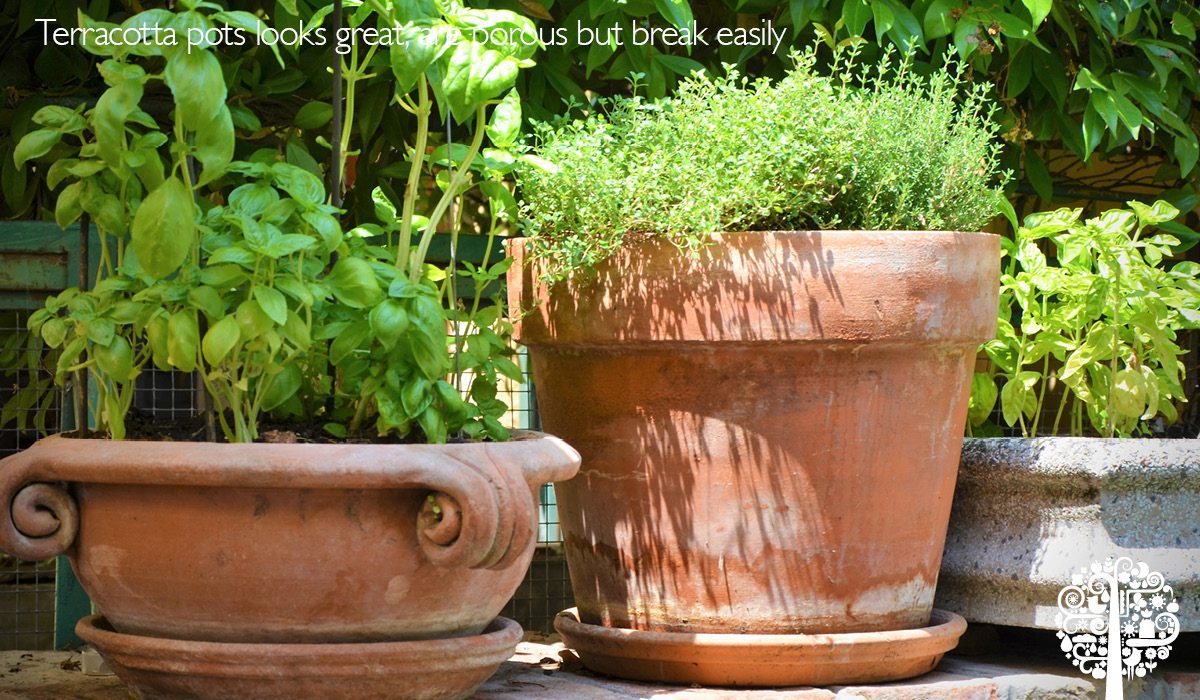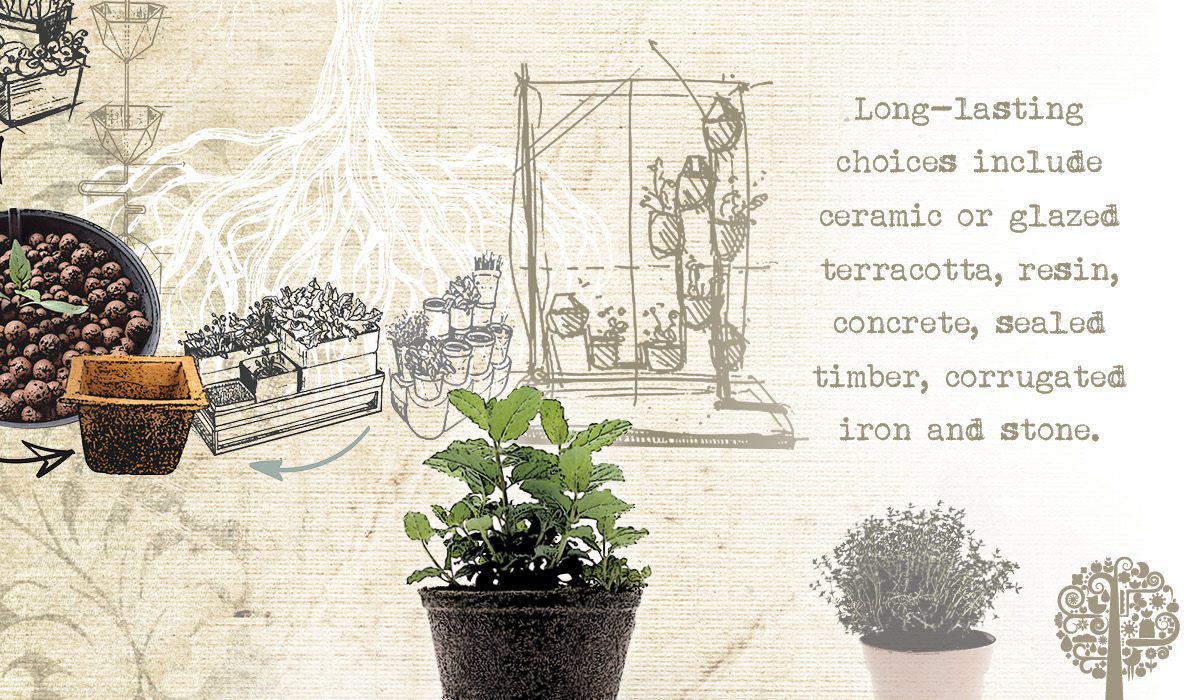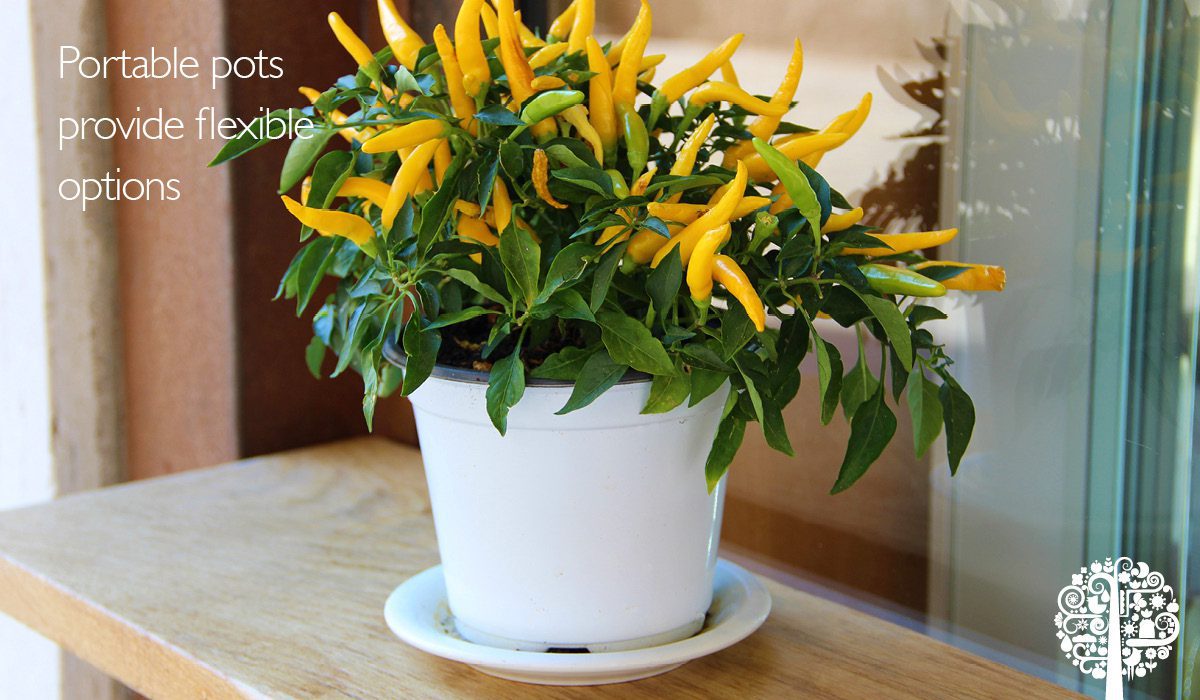More people than ever are learning to grow edible gardens, especially in small urban areas. With limited space, container gardens are an obvious solution. However, selecting the right container can be confusing with so many options available. There are some factors to consider that can make the decision easier and avoid potential problems.
Drainage
All plants need oxygenated soil to thrive and the ability for water to percolate through and escape. However, not all pots have adequate drainage holes. Unfired clay or terracotta, for example, usually have just one large hole in the base. If roots become matted or a taproot pokes through this single drainage hole, the soil may become waterlogged. In this case, it’s best to choose plants with a fibrous root system rather than a taproot.
Plastic pots are easy to drill extra holes into if needed. Fabric root pouches leach moisture through the sides and base, similar to coir-lined hanging baskets. Planter bags usually have adequate perforations.
Think about where the water will eventually go. Will it leach out onto a surface that may be damaged or stained? Or will it drip down from an upper floor balcony to a neighbour below? Pot saucers or trays may be a solution to protect the area.
Weight
Fabric and plastic pots are lightweight and easy to move around. Other materials like concrete, ceramic, stone, timber and resins can be hefty. This can, however, be an advantage if you are exposed to strong winds. Heavy, squat containers are more stable and suit tall plants that could otherwise topple over if not firmly anchored.
Another consideration is the total weight of the pot, including fully saturated soil and the plants. This can be an essential factor for balcony gardeners or those locating pots on decks or rooftops. Check the engineered structural strength of the balcony first to ensure it is adequately weight-bearing, particularly if you plan to add a lot of plants.

Heavy containers are also challenging to move, so you need to put them in their permanent position or on castors. If renting or on the move, lightweight containers may be easier to relocate.
The weight of a mature plant such as a fruit tree increases each year, particularly when bearing fruit. Grow bags can be a good choice for these trees. They have handles, and the bag is easy to remove – much like pulling down pants – without resulting in transplant shock! Replant the tree into the next size up.
Porosity
Breathable or porous containers allow air and moisture to move through them. Examples include unfired clay or terracotta, fabric root pouches, felt, woven sacks, paper pulp and natural materials.
Porous pots allow moisture to evaporate from the material, which helps prevent root rot. However, they also dry out faster, particularly in full sun. So more frequent watering is required. Otherwise, plants can experience water or heat stress. Small clay pots and hanging baskets with coconut fibre (coir) lining are particularly vulnerable to drying out, especially on hot, windy days. They are best suited to edibles like hardy Mediterranean herbs that need infrequent watering.
Food Safety
One of the most important considerations is whether the planter is suitable for growing food. Some containers will leach chemicals into the soil and be taken up by plant roots. Root crops are particularly vulnerable.

Most plastic pots are made from polypropylene (PP), identified with recycling number 5. PP is tough and heat resistant and used widely in the garden industry. It is considered one of the safer plastics, unlike numbers 1, 3, 6 and 7.
Materials to watch out for include:
• Concrete – Leaches lime that is lethal to many plants. You can water a concrete pot thoroughly many times, so the water drains away and surplus lime disperses. Or leave it outdoors in the rain for several weeks before planting.
• Treated timber – Many wood products today incorporate preservatives, fungicides, insecticides and formaldehyde-based glues. The International Agency for Research on Cancer has classified formaldehyde as a Category 1 ‘known human carcinogen’ (IARC 2008). Formaldehyde will off-gas in many commonly used forms, particularly in new products and in high heat and humidity. Look for wood planters made from sustainable untreated timber as a safer option.
Many gardeners upcycle containers to grow food. It’s best to know what was in them previously to make sure they’re not contaminated.
If you’re not sure if a container is safe for edibles, it’s best to err on the side of caution. I apply the Precautionary Principle in my garden. You can check with the product manufacturer or search for the SDS/MSDS (Material Safety Data Sheet). This describes the chemical properties of a product and may help you check for potentially harmful contaminants. See msdsonline.com/sds-search.
Mobility
If you have limited sunlight, move house regularly, or overwinter plants, lightweight, portable pots may be best. Mobile containers also provide more flexibility:
• Move sun-loving crops to sunny positions as light changes during the year;
• Relocate pots to provide shade relief during hot summers;
• Protect crops from wind, storms, frost or snow;
• Move indoors or take small pots with you when travelling.
Lightweight, portable pots are also easier to stack or hang vertically to maximise space and provide a more aesthetic garden.
Environmental impact
Does the sustainability or ethics used during the manufacture matter to you? Issues like transportation, fossil fuels, environmentally destructive processes and international production are aspects to consider. Check where the product is made and research the manufacturing process. Is it eco-friendly?
You may want to choose products that use recycled components or tread lighter on the planet with other initiatives. Buy locally made or upcycle containers to minimise resources.
Cost
Buying new pots is an investment. If you choose durable container materials and plan to use them for a long time, it can be worth spending extra money. You may be able to save on delivery by picking them up locally from a garden centre or retail outlet.
If your pots have been manufactured overseas or interstate, transportation costs will be built into the retail price. Locally made containers will likely be more economical and support businesses in your community. With a restricted budget, DIY or upcycled containers may be the most cost-effective options. Weigh up the cost to the environment when making your choice.
Durability
If you need a container just for a short time, it may not matter how long it lasts or what it looks like. Consider if you can reuse the pot and embodied energy to extend its long-term value.
If you are designing a garden or want a feature pot that looks important, a durable container is ideal. Long-lasting choices include ceramic or glazed terracotta, resin, concrete, sealed timber, corrugated iron and stone.
While polystyrene boxes are cheap and readily available, they degrade relatively quickly in strong sunlight. Some cheap plastics become brittle and crack or fade, but most go the distance.
Coir fibre liners in hanging baskets generally last around five years unless resourceful birds steal the fibres for nest-making!
Self-Irrigating
Many planters have a self-watering reservoir in the base that holds water. The moisture wicks upwards via the surface tension that is created into the potting mix. So plant roots are not over or under-watered. This reduces the likelihood of drought stress or waterlogging and root rot. This design helps maintain moisture levels to encourage healthy plant growth.
Self-watering pots are an ideal choice for forgetful and time-poor gardeners or travellers who need a buffer to keep their plants alive while they’re away for a few days. They save you time not having to water every day. These types of containers particularly suit edibles that need consistent moisture, like fruiting crops and leafy greens.
Air Pruning
If you want to grow a plant such as a fruit tree to a specific size and then transplant and repot as it grows, rigid materials like plastic or ceramic may not be the best choice. When plant roots hit the side of the container, they start circling it. Instead of growing evenly downwards and inwards, the roots have nowhere else to go except around. This often causes the plant to become pot bound.

When it comes time to transplant, it may be harder to remove it from the pot. Root trimming is then required with the associated risk of transplant shock. In this case, air pruning pots may be a better choice. These containers assist healthier root development. They are designed with air holes or breathable fabric that encourages the plant roots to self-prune. When the roots reach the side or base of the container and encounter air, the root tips dry out and stop growing. They naturally sheer off, so the plant develops dense, fibrous lateral roots within the container.
Air pruning containers encourage higher yields for fruiting crops, reduce transplant shock and root diseases but can be more expensive than other materials. Many versions include washable, reusable fabric root pouches, grow bags and solid plastic containers with air holes on the sides and base. Some brands are BPA free, which is another health consideration for food plants.
Aesthetics
The appearance of your pots is a very personal decision. We all have different tastes in the colours we prefer and the size or shape we need for the space we have. If you’re restricted due to budget, you may have limited choices. Functionality may take precedence over beauty!

You may want to coordinate the theme of your container garden with a uniform look by grouping pots of the same colour or style. Perhaps you prefer quirky or ornamental DIY containers that reflect your personality. The most important consideration is you love the look of it!
Insulation Properties
Where climate challenges like frost, snow or high temperatures affect plants, pot choice can be an essential factor to consider. Metal containers provide minimal insulation and heat up rapidly in direct sunlight. This can dry out the potting mix as it shrinks away from the sides, increasing the likelihood of root damage.

Stone, concrete and ceramic pots are suitable insulating materials. They are suited to climates with extreme temperatures, helping to shield delicate plant roots and soil microbes from harsh conditions. Polystyrene boxes that are often used as a DIY container option have excellent thermal properties but do deteriorate quickly in strong UV sunlight, potentially leaching styrene into the soil.
With so many factors to consider, it’s a matter of weighing up the pros and cons of the different types of containers when planning your food garden and choosing those that best meet your personal needs.